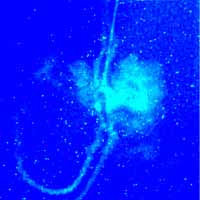| . |  |
. |
 Kirtland (AFPN) - October 27, 1999 - An Air Force Research Laboratory astronomer calls them "glowworms in the sky" and scientists will soon gather at the laboratory's Starfire Optical Range to study them.
Kirtland (AFPN) - October 27, 1999 - An Air Force Research Laboratory astronomer calls them "glowworms in the sky" and scientists will soon gather at the laboratory's Starfire Optical Range to study them.Between Nov. 16 and 19, scientists will gather at Starfire to train a variety of instruments on the Leonid meteor shower. Grains of sand and dust from the comet Temple Tuttle produce these meteors. Named for the constellation Leo, from which they appear to emanate, these meteors vaporize in the Earth's atmosphere. According to Dr. Jack Drummond, the laboratory's Directed Energy Directorate astronomer, the Leonid meteors leave behind trails which, unlike ordinary meteors that fade in a matter of seconds, can last up to an hour and are still unexplained. "I call these lingering meteor trails 'glowworms in the sky' since they are not only visible for minutes by chemical reactions, but are twisted by the winds into serpentine shapes, appearing like snakes or worms," Drummond explained. Scientists hope to gather enough information to explain one of the more curious atmospheric phenomena -- What makes the meteor trails glow? The glow, called chemiluminescence, is the production of light from chemical reactions similar to bioluminsescence, the same kind of glowing reaction found in biological entities such as fireflies and their larvae, glowworms. Drummond, who last year guided lasers onto the trails when they appeared last November, said the lingering meteor trails are self-luminescent. "They do not shine by reflected moonlight or sunlight," he said, adding, "but the exact chemical reactions involved are unknown." The scientists will direct a lidar, a laser that operates at visible wavelengths to gather data, onto the lingering trails. This instrument, on loan from the University of Illinois, was steered onto meteor trails last year to probe the meteors' compositions. The data gathered by the lidar, which is attached to the 3.5-meter telescope at Starfire, indicates that although sodium may be involved in a catalytic reaction with ozone to produce sodium airglow, it is not the principle emission from the trails. This year, additional instruments will be used to try and identify the emission lines. Three spectrographs will be aimed at the trails to try and determine the chemical reactions that are responsible for the glow. A spectrograph divides light into a color spectrum, revealing bright (emission) and dark (absorption) lines produced by elements and molecules. The operation of two spectrographs, one from the University of Arizona and one from the University of Illinois, will study light visible to the naked eye. The third spectrograph, from Aerospace Corporation, will study light in the infrared at wavelengths that are not visible to the naked eye. An electronic charge-coupled device camera and video camera will be used to record the changing appearance of the trails. Shown at several conferences, last year's 13-minute video, "blew the audiences away," according to Drummond. He said most people have never seen or heard of these 'glowworms in the sky' which are characteristic of the Leonid Meteor showers. The scientists hope to answer why the 'glowworms' are peculiar to the Leonid storm periods, which occur every 33 years, and why they are rarely seen at other times. They wonder if it may imply something about the composition of the parent comet. Although this year's shower is expected to peak over Europe on the morning of Nov. 18, it is hoped that some of the fireball components of the storm will be visible locally one or two days before or after the main peak. Here, on a dark quiet mountaintop on the southern end of Kirtland Air Force Base, N.M., scientists will be watching, waiting and hoping to unravel a mystery occurring 60 miles overhead.
SPACE SCIENCE
|
| |||||||||
| The content herein, unless otherwise known to be public domain, are Copyright 1995-2016 - Space Media Network. All websites are published in Australia and are solely subject to Australian law and governed by Fair Use principals for news reporting and research purposes. AFP, UPI and IANS news wire stories are copyright Agence France-Presse, United Press International and Indo-Asia News Service. ESA news reports are copyright European Space Agency. All NASA sourced material is public domain. Additional copyrights may apply in whole or part to other bona fide parties. Advertising does not imply endorsement, agreement or approval of any opinions, statements or information provided by Space Media Network on any Web page published or hosted by Space Media Network. Privacy Statement All images and articles appearing on Space Media Network have been edited or digitally altered in some way. Any requests to remove copyright material will be acted upon in a timely and appropriate manner. Any attempt to extort money from Space Media Network will be ignored and reported to Australian Law Enforcement Agencies as a potential case of financial fraud involving the use of a telephonic carriage device or postal service. |